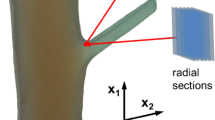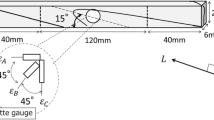Abstract
Direct measurement of strain field in a mechanically loaded Norway spruce branch–stem junction was performed by means of electronic speckle pattern analysis. Results were compared with strain distribution in a polyester cast of identical shape as the branch–stem junction, and a simplified polyester model consisting of two half-cylinders. Compared to polyester models, the branch–stem junction was characterised by a very homogeneous distribution of strain, which can be interpreted as a homogeneous distribution of stress in terms of fraction of material strength. This optimised transfer of mechanical load from the branch to the stem is achieved by a combination of naturally optimised shape with, additionally, optimised mechanical wood properties in the junction area.





Similar content being viewed by others
References
Dantec–Ettemeyer (2001) ISTRA for Windows, Version 3.3.12. Dantec Ettemeyer GmbH, Ulm, Germany
Dumail JF, Kenneth O, Salmén L (2000) An analysis of rolling shear of spruce wood by the iosipescu method. Holzforschung 54:420–426
Eberhardsteiner J (1995) Biaxial testing of orthotropic materials using electronic speckle pattern interferometry. Measurement 16:139–148
Eberhardsteiner J (2002) Mechanisches Verhalten von Fichtenholz—Experimentelle Bestimmung der biaxialen Festigkeitseigenschaften. Springer, Wien New York
Färber J, Lichtenegger HC, Reiterer A, Stanzl-Tschegg S, Fratzl P (2001) Cellulose microfibril angles in a spruce branch and mechnical implications. J Mater Sci 36:5087–5092
Fournier M, Bordonne PA, Guitard D (1990) Growth stress patterns in tree stems. Wood Sci Technol 24:131–142
Gindl W, Sretenovic A, Vincenti A, Müller U (2005) Direct measurement of strain distribution along a wood bond line—Part II: Effects of adhesive penetration on strain distribution. Holzforschung 59:307–310
Kollmann FP, Coté WA (1968) Principles of wood science and technology. I: Solid wood. Springer-Verlag, New York Inc
Mattheck C (1991) Trees – the mechanical design. Springer-Verlag, Berlin Heidelberg New York
Mattheck C, Breloer H (1994) Handbuch der Schadenskunde von Bäumen – der Baumbruch in Mechanik und Rechtsprechung. Rombach Verlag, Freiburg
Mattheck C, Kubler H (1997) Wood – the internal optimization of trees. Springer-Verlag, Berlin Heidelberg, New York
Mattheck C (1998) Design in nature – learning from trees. Springer-Verlag, Berlin Heidelberg New York
Mohan NK, Rastogi P (2003) Recent developments in digital speckle pattern interferometry. Opt Lasers Eng 40(5/6):439–445
Müller U, Sretenovic A, Vincenti A, Gindl W (2005) Direct measurement of strain distribution along a wood bond line – Part I: Shear strain concentration in a lap joint specimen by means of electronic speckle pattern interferometry. Holzforschung 59:300–306
Rastogi PK (2001) Measurement of static surface displacements, derivatives of displacements, and three-dimensional surface shapes – examples of applications to non-destructive testing. In: Rastogi PK (ed) Digital speckle pattern interferometry and related techniques. John Wiley & Sons, pp 141–224
Reiterer A, Lichtenegger H, Tschegg S, Fratzl P (1999) Experimental evidence for a mechanical function of the cellulose microfibril angle in wood cell walls. Philos Mag A 79(9):2173–2184
Reuschel JD (1999) Untersuchungen der Faserandordnung natürlicher Faserverbunde und Übertragung der Ergebnisse auf technische Bauteile mit Hilfe der Finite-Elemente-Methode. Dissertation, Forschungszentrum Karlsruhe GmbH, Karlsruhe
Salmen L, DeRuvo A (1985) A model for the prediction of fiber elasticity. Wood Fiber Sci 17(3):336–350
Shigo AL (1985) How tree branches are attached to trunks. Can J Bot 63:1391–1401
Shigo AL (1990) A new tree biology. Thalacker, Braunschweig
Siebert T, El-Ratal W, Wegner R, Ettemeyer A (2002) Combine simulation and experiment in automotive testing with ESPI measurement. Exp Tech May/June:42–47
Timell TE (1986) Compression wood in gymnosperms. Springer, Berlin
Trendelenburg R (1955) Das Holz als Rohstoff. Carl Hanser Verlag, München
Author information
Authors and Affiliations
Corresponding author
Additional information
Communicated by T. Speck
Rights and permissions
About this article
Cite this article
Müller, U., Gindl, W. & Jeronimidis, G. Biomechanics of a branch – stem junction in softwood. Trees 20, 643–648 (2006). https://doi.org/10.1007/s00468-006-0079-x
Received:
Accepted:
Published:
Issue Date:
DOI: https://doi.org/10.1007/s00468-006-0079-x




